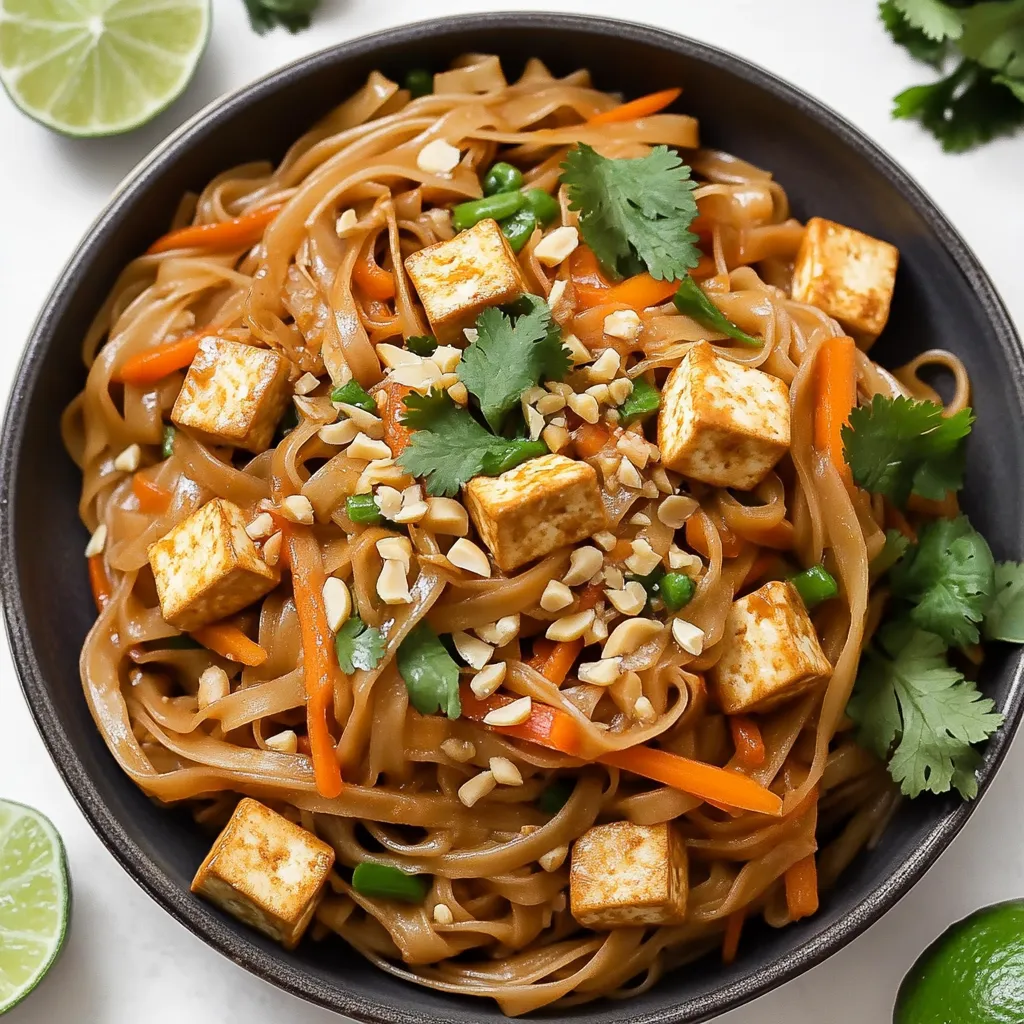 Pin it
Pin it
A vibrant twist on the classic Thai street food favorite, this vegan Pad Thai delivers all the authentic flavors without any animal products. The combination of chewy rice noodles, crispy tofu, and a perfectly balanced sauce creates a restaurant-quality dish that comes together in just 30 minutes. Each forkful offers a beautiful harmony of sweet, sour, and savory notes that will satisfy both vegans and non-vegans alike.
I've spent months perfecting this vegan version of Pad Thai, testing numerous variations until finding the perfect balance. Last week, I served this to my Thai neighbor who was skeptical about vegan Pad Thai - she ended up asking for seconds and the recipe!
Essential Ingredients
- For the Noodles and Protein:
- 8 oz rice noodles: Choose flat stir-fry noodles, often labeled as "Pad Thai noodles"
- 1 block extra-firm tofu: Look for tofu with minimal water content for best frying results
- 2 tablespoons vegetable oil: Any neutral oil with a high smoke point works well
- For the Signature Sauce:
- 3 tablespoons low-sodium soy sauce: Creates the savory base of the sauce
- 2 tablespoons rice vinegar: Provides essential tanginess without tamarind
- 2 tablespoons maple syrup: Real maple syrup adds depth beyond just sweetness
- 1 lime: Fresh juice adds brightness and authenticity
- 1-2 teaspoons sriracha: Adds warmth and subtle heat to the dish
- For the Vegetables:
- 2 medium carrots: Choose firm, bright orange carrots for best flavor
- 3 green onions: Look for crisp stalks with bright green tops
- 1 cup bean sprouts: Fresh sprouts add essential crunch
- ½ cup fresh cilantro: Bright green bunches indicate freshness
- For Garnish:
- ½ cup crushed peanuts: Dry roasted, unsalted provide best texture
- Extra lime wedges: Fresh citrus brightens the final dish
- Additional cilantro: For fresh herb garnish
 Pin it
Pin it
Detailed Cooking Instructions
- Step 1: Prepare The Noodles
- Bring a large pot of water to a rolling boil. Add your rice noodles and cook until they're just al dente - about 1 minute less than package directions suggest. Immediately drain and rinse with cold water to stop the cooking process. Toss with a tiny splash of oil to prevent sticking. This precise timing ensures your noodles won't become mushy in the final dish.
- Step 2: Press And Prepare Tofu
- Drain tofu and wrap in clean kitchen towels or paper towels. Place a heavy object on top and let sit for 15 minutes to remove excess moisture. Cut into 1-inch cubes. This thorough pressing is crucial for achieving that perfect crispy exterior.
- Step 3: Create The Sauce
- In a medium bowl, whisk together soy sauce, rice vinegar, maple syrup, lime juice, and sriracha until well combined. The sauce should taste balanced - equally sweet, sour, and savory. Adjust seasonings to your preference, remembering that flavors will mellow slightly when mixed with other ingredients.
- Step 4: Crisp The Tofu
- Heat oil in a large wok or skillet over medium-high heat until shimmering. Add tofu cubes in a single layer, being careful not to crowd the pan. Cook for 2-3 minutes on each side until golden brown and crispy. Remove tofu and set aside, leaving any remaining oil in the pan.
- Step 5: Stir-Fry Vegetables
- In the same pan, add carrots and the white parts of green onions. Stir-fry for 2-3 minutes until carrots are just tender-crisp. The goal is to maintain some crunch while taking the raw edge off.
- Step 6: Combine And Finish
- Add prepared noodles and sauce to the pan, tossing everything together with tongs. Return tofu to the pan and add bean sprouts. Cook for 2-3 minutes until everything is heated through and well-combined. Add green parts of onions and half the cilantro in the final minute.
 Pin it
Pin it
During my recipe testing phase, I discovered that maple syrup creates a more complex sweetness than traditional sugar. It adds subtle caramel notes that complement the umami from the soy sauce perfectly.
The Art of Balancing Flavors
Thai cuisine is built on the principle of balancing sweet, sour, salty, and spicy elements. If your dish tastes one-dimensional, adjust the sauce components: add maple syrup for sweetness, lime juice for sourness, soy sauce for saltiness, or sriracha for heat.
Make-Ahead Strategy
The beauty of this recipe lies in its prep-friendly components. I often prepare double batches of the crispy tofu and sauce, storing them separately. This turns weeknight dinner assembly into a 10-minute affair.
After perfecting this recipe over countless iterations, I've found it delivers all the satisfaction of traditional Pad Thai while remaining completely plant-based. The key lies in understanding that each component plays a crucial role in the final dish - from the perfectly cooked noodles to the crispy tofu and balanced sauce. Whether you're an experienced cook or new to Thai cuisine, this recipe provides a delicious introduction to the vibrant world of plant-based Asian cooking.
Frequently Asked Questions
- → Can I make this pad thai gluten-free?
- Yes, simply use tamari instead of soy sauce to make it gluten-free. All other ingredients are naturally gluten-free.
- → What can I use instead of tofu?
- You can replace tofu with extra vegetables like bell peppers, broccoli, mushrooms or snap peas for a veggie-packed version.
- → How spicy is this pad thai?
- The recipe calls for just 1 teaspoon of Sriracha, making it mildly spicy. Add more Sriracha or chili sauce to increase the heat level.
- → Can I prep any ingredients ahead?
- Yes! Cut the tofu, julienne the carrots, chop herbs and mix the sauce up to 2 days ahead. Store prepped ingredients separately in the fridge.
- → How long do leftovers keep?
- Leftover pad thai will keep for 3-4 days in an airtight container in the fridge. The noodles may soften slightly when reheated.
